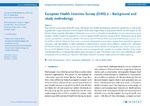European Health Interview Survey (EHIS) 2 – Background and
study methodology
Robert Koch-Institut
The scientific assessment of health issues, the design and further development of political guidelines as well as the
targeted planning of measures in the European Union (EU) require data on population health. For this reason, all EU
Member States regularly collect data on the health status, provision of healthcare, health determinants and socioeconomic
situation of their respective populations in the European Health Interview Survey (EHIS). Participants are at least
15 years old and live in private households. The second wave of EHIS (EHIS 2) was conducted between 2013 and 2015.
For EHIS 2, each EU Member State drew a nationally representative population sample from population registers,
censuses, dwelling registers or other statistical or administrative sources. Data collection modes within individual
EU Member States were used, according to nationally established methods, including the use of mixed-mode surveys.
Across all EU Member States, data collection took an average of eight months to complete. Member States made
considerable efforts to achieve the highest possible response rates. The harmonised EHIS data collected are highly
comparable and constitute an important information base for European health policy and health reporting.
Files in this item

